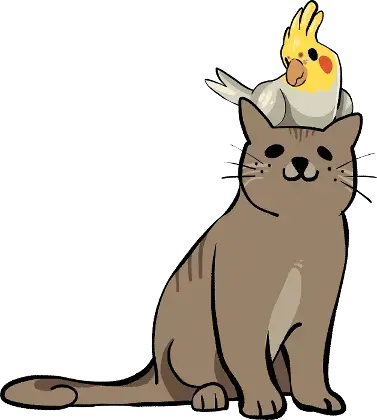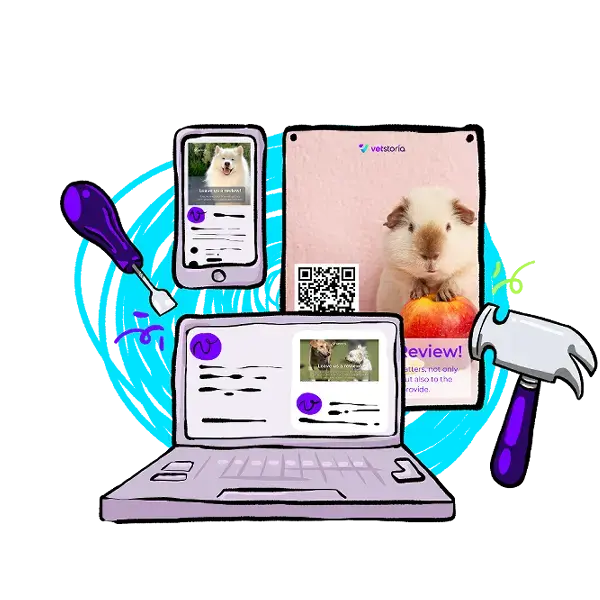Teach pet owners about Halloween dangers
Help pet owners protect their pets this spooky season with this new content pack! This pack educates pet owners on the dangers of candy, costumes and decorations to ensure the whole family can have an enjoyable Halloween.
Download our ready-to-use social assets:
Or brand the content for your clinic in 3 easy steps

Choose the pack you want, and open the clickable template links

Export the design as it is, or add your logo, brand colors, and update the text

Download the design for your digital channels, or print physical copies!
Customize the assets as you like:
What information is included in the Halloween content pack?
Chocolate – It may seem like a tasty treat, but chocolate is very poisonous for our pets. The darker the chocolate, the greater the danger.
Artificial sweeteners – Xylitol, a common artificial sweetener used in sugar-free candy, is deadly to pets. You might not always be able to tell from individually-packaged candy if it has this ingredient, so it’s better to avoid giving pets human candy altogether.
Candy and sweets – Excessive consumption of sweet, fatty foods can cause pancreatitis in pets. In addition, human candy might contain other ingredients that are toxic to our pets.
Lollipops, and candy packaging – Pets might try to devour sweets whole: packaging and all. The packaging can clump up and cause intestinal blockages, and the sticks in lollipops might present a choking hazard.
Raisins – Sometimes given as a healthy alternative to candy, raisins are extremely toxic to dogs, as are all grape products.
While decorating for Halloween, it’s important to keep our pets in mind. Some decorations may pose a danger to them, if they are within reach and are not properly secured. Keep in mind the following:
Fake spider webs – Pets explore their environment with their mouth, and Halloween decorations are a change to the pet’s environment. Fake spider webs can get tangled and cause intestinal obstructions when swallowed. Keep them out of reach!
Glow sticks – The liquid inside glow sticks and other glow jewelry can cause drooling, foaming at the mouth, and irritation. Dogs, but especially cats, can be tempted to chew on them and release the liquid. Keep them out of reach!
Candles – Candles and Jack o’ Lanterns can be a fire hazard if pets knock them over. Keep them out of reach and safely secured in their place. Alternatively, opt for electric candles instead!
Electrical cords – Pets may chew on electrical cords, especially if they’re new to the pet’s environment. This can cause electrocution and other injuries. All electrical cords should be secured or taped down, to avoid pets chewing on them or getting tangled in them.
Hair dye – Hair dye should never be used on pets, as they tend to lick them from their fur and can be poisoned by it.
Small decorations – Small bits, like fake bugs, or pieces from costumes, are a choking hazard for pets. Ensure you remove these from reach, and ensure every part of a costume is securely attached and unlikely to rip away.
Veterinarians recommend pet’s never wear costumes.
Clothes cause discomfort to our pets, and pets can tear or chew off little bits of fabric, decorations or cords. These can be a choking hazard, or tangle in their stomach and cause intestinal blockages. Try using Halloween-themed pet bandanas as a safe alternative!
Masks are especially dangerous, as they can cause pets to suffocate. Never cover your pet’s face.
Pets should only wear clothes for functional, safety purposes (like winter coats or protective booties).
If your pet does wear a costume, ensure it is loose enough to not restrict movement, but not too long to be a tripping hazard. Ensure it doesn’t affect their hearing, sight and, most importantly, breathing. Brachycephalic dogs, like pugs, are more at risk of suffocation. Pets should never be left unsupervised while wearing a costume.
Hearing the doorbell repeatedly can be stressful for your pet. Add to that the strangers entering their house, in strange, scary costumes, and even the mildest pet can get scared or aggressive.
Here’s what you can do to minimize the stress for your pet:
Busy streets – The streets will be busier than usual during the evening. The scary costumes and weird smells can stress your dog out, and discarded candy and wrappers pose a danger to your pet. Excited children might come over to pet your dog, overwhelming them, and overwhelmed animals tend to run away or bite.
Try walking your dog earlier in the day, or through less-busy streets. Keep them close to you on a non-retractable leash, and be mindful to protect them from strangers.
Keep your pet in a separate room – If your pet has a kennel they spend time in, even better! Keep the door closed, give them comfort toys and blankets, and leave music or white noise running to disguise the noise.
Even if you have a secure fenced-in garden, or your pet is primarily outdoor, it is a good idea to get them inside during Halloween night itself.
Secure escape routes – during the stress of Halloween evening, pets can become fearful and try to run away. You can avoid this by ensuring that your pet is inside the house and all exits are secure. (This also means not allowing them access to the front door, as you might be opening it frequently during the evening!)
If your pet runs away, it’s important their microchip is up-to-date, and that they have an appropriate collar with the necessary info on their tags.
Your costume – Let your pet get used to your costume before the day. Avoid using masks, as this can make you less recognizable and might cause a stressed pet to lash out. Avoid having small buttons, cords or decorations, as they can get torn off and become a choking hazard.
Doorbell and noise – if you can, try staying outside your house, intercepting trick-or-treaters before they reach the door. This will reduce the amount of noise your pet hears, as well as the feeling of having strangers intruding on their space.
Fireworks – it isn’t uncommon for people to use fireworks during Halloween. Keeping your pet away from the noise, with soft blankets and music playing to muffle it, is a good choice. If your pet is particularly anxious, contact your vet in advance, as they can prescribe medication to make this stressful time easier on your pet. For more information, check out our Fireworks pack!
Our Content Pack Calendar has all the marketing assets you need for the rest of the year neatly mapped onto a calendar. It’s been specially designed to help you have the most engaging, productive, and profitable quarter yet for your veterinary clinic. Download 2023 Q4 calendar here!

Get Vetstoria Content Packs direct to your Inbox
Vetstoria users get more, with online booking links and QR codes

Build online booking campaigns
Create promotional booking campaigns (like free dental check ups!) that follow set scheduling rules based on your preferred dates, the availability of vets, and more!

Add trackable booking links and QR codes
Use trackable links in emails, SMS, social profiles, online ads and in the clinic to promote your campaigns and easily measure the results.

Use analytics to optimize results
See how many appointments and new clients are generated from each campaign, and learn which channels are most effective.

Build online booking campaigns
Create promotional booking campaigns that follow set scheduling rules based on preferred dates, the availability of vets, and more!

Add booking links to digital channels
Use trackable booking links in emails, SMS, social profiles, and online ads to promote your campaigns and easily measure the results.

Use analytics to optimize results
See how many appointments and new clients are generated from each campaign, and learn which channels are most effective.


